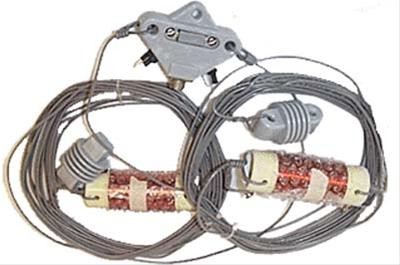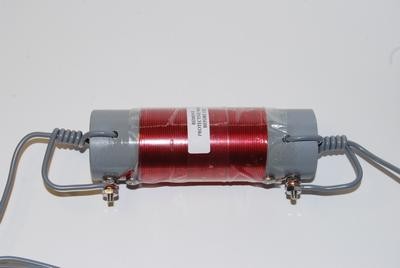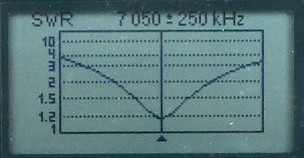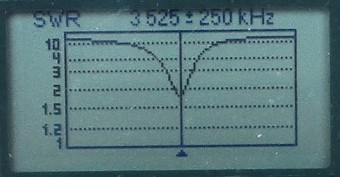
Hacking the Alpha Delta DX-DD
Matt Roberts - matt-at-kk5jy-dot-net
Published: 2018-04-06
Updated: 2022-08-19
What's a DX-DD?
 There are several antenna designs that can be used for NVIS communication on
40m and 80m, but the one I keep coming back to is the DX-DD, from Alpha Delta.
The antenna is smaller than a full-sized dipole for 80m — and even shorter than
the popular G5RV — but it still has good high-angle performance on both bands.
The loading devices are simple wire coils, which means no capacitors to burn out
(or drift) like you have with a typical trap antenna.
There are several antenna designs that can be used for NVIS communication on
40m and 80m, but the one I keep coming back to is the DX-DD, from Alpha Delta.
The antenna is smaller than a full-sized dipole for 80m — and even shorter than
the popular G5RV — but it still has good high-angle performance on both bands.
The loading devices are simple wire coils, which means no capacitors to burn out
(or drift) like you have with a typical trap antenna.
The antenna design is actually quite simple, with coil forms made from PVC
pipe and magnet wire wrapped in a close-wound inductor. Using coils like
this for multiband dipole antennas is an idea that has been around for a while,
but Alpha Delta has commercialized their production, offering this 40m/80m antenna,
as well as a 40m/80m/160m version, the DX-LB.
Why the DX-DD?
This antenna is a good one for "typical" NVIS usage. During a solar
peak, that means 40m during the day, and 80m in the evening and during the overnight
hours. Now that we are entering a solar minimum, NVIS mostly means 80m through
the day and early evening, and 160m at night — sometimes. I chose the
two-band DX-DD over the three-band DX-LB, mostly for reasons explained in the sidebar
at right.
Although 80m is the consistent workhorse band for NVIS throughout the
sunspot cycle, having an effective antenna for 80m can be a bit of a
challenge. For one thing, an 80m dipole is long — around 133' long at
the bottom of the band. Another challenge with 80m is elevating the antenna
to a height where ground losses are kept in check. Most people advocate an
installation height on 80m somewhere between 15' and 35' above the ground.
There are advantages to installing NVIS antennas on the low end of that scale,
but doing so requires lifting the entire antenna (not just the center) to keep
ground losses under control. So the larger the antenna is, the more work
it takes to get its entire length elevated to the proper height.
That's why I have come to settle on the DX-DD design for NVIS work:
- Excellent performance on 40m (when 40m is available for NVIS)
- Good performance on a few dozen kHz of 80m, gain similar to G5RV
- Compact 88' wingspan
- 33% less than a full-sized 80m dipole
- 23% less than a G5RV
- Two bands, one antenna:
- minimum installed footprint
- much smaller than with single-band crossed dipoles
- Loading coils are lightweight and durable, and near the ends of
the antenna:
- easy to support
- minimizes sag and lateral wire tension
- produces better current distribution
- improves gain and 50-ohm match
- 250W continuous power handling:
- more than enough for high-angle contacts
- full legal limit on SSB, CW, FH, etc. with appropriate material
selection
For NVIS work, the DX-DD is a great balance between mechanical and electrical
needs. However, the DX-DD does have a significant drawback — cost.
Retail pricing for the DX-DD is $150. The antenna does not include a
choke for the feedpoint, so by the time you add a commercial coaxial choke
that is capable of 80m operation, the cost can easily exceed $200.
While a prefabricated antenna can be very convenient, that kind of cost
is simply not necessary for an antenna that is essentially wire and plastic.
I set out to make my own copy of the DX-DD, using materials that I had on-hand,
to see if this very capable antenna design could be done on the cheap, but
still maintain the characteristics that make it such a good performer for NVIS
work.
Spoiler alert: it's not difficult at all.
Be aware that this news story is still developing. I have a working antenna,
and I'm satisfied with the results, but I'm still playing with it, so this article
will likely change as time goes by.
Requirements
There are two main components to the antenna — one is the feedpoint, and one
is the loading coils. Being able to clone the antenna successfully is
dependent upon proper construction of these two components, because they
determine the electrical performance of the antenna. Everything
else is just mechanical. So the first step is to look at these two
components in more detail.
The Loading Coils
The original
DX-DD manual
describes the loading coils as ISO-RES, whatever that means. The devices are
obviously simple wire inductors, made from enamel-coated magnet wire. The
operation of the coils in the circuit is not described by the manual, but it does
claim that they are not traps. They are certainly not classical traps, with
independent inductor and capacitor sections, nor are they the coaxial trap designs
used by many hams, where the coax windings provide both the L and C values
intrinsically needed to form the filter that is a typical trap.
I'll write later about what these devices might actually be doing, but for now, it
is sufficient to simply describe how to faithfully reproduce them. Using a
set of precision calipers, I determined that the dimensions of a finished ISO-RES
coil for the DX-DD has the following characteristics:
- 69 Turns of #18 enameled magnet wire, close wound (adjacent turns touching)
- Overall coil length is 2.935", with the length being entirely determined by
the gauge of the wire and the number of turns
- Coil wrapped on PVC with 1.655" OD, and 5.25" overall length
- Coil wire anchored at each end by stainless hardware
- Attachment to the dipole wires is done by feeding those wires through holes
in the PVC, and then securing the loop to prevent slipping
I found some thin-walled PVC at Lowe's that just happened to have the exact OD
required, and the fact that it was thin-walled is a bonus for weight savings.
I used the same wire (#18 enameled) to wind the inductor, and the dimensions in
the end were very close to those measured on the commercial product.
I also tooks some small liberties with the new design, each of which turned out
to work just fine. First, I used 70 turns to form the inductor. The
extra L allowed the finished antenna to be slightly shorter than the commercial
version, but resulted in resonances that were nearly identical. AD used
two sets of fasteners on each coil — one to secure the coil windings,
and a second to attach the wire spans. Since the fasteners are not load
bearing, I used one set of #4 machine screws for both functions. I also
drilled some small holes at the ends of the coil itself, and threaded the
magnet wire through these holes to help hold it in place while I installed
the hardware.
The manual
for the DX-DD says that the coils are coated with a UV-resistant coating, but doesn't
identify it. The coating that I used was a clear enamel, available in a spray
can in the paint section of Lowe's or any other home improvement store.
The product name is Rust-oleum Crystal Clear Enamel, and the manufacturer's
website says that their enamels have significant UV resistance. Once the new
coils were completely constructed, I masked the stainless hardware with tape (since
that's where the wires attach), and then applied one generous coat of spray enamel
to the entire coil assembly. The resulting coil was very nice and shiny looking,
and should be reasonably resistant to exposure to the elements.
The new coil is shown below, next to the commercial version for comparison.

Figure 1: Completed Home-made Inductor

Figure 2: Original Alpha-Delta Inductor
The loops formed to secure the longer inner spans to the center insulator (described
below) were constructeed similarly to those on the loads. I left just enough slack
in the pigtails to allow sufficient wire movement due to wind, installation, etc.
The Feedpoint
This is where we have to discuss the difference between the ideal world and
reality. The DX-DD manual claims that most installations shouldn't
require a choke on the antenna feedline.
Rubbish. :-)
All amateur HF antennas (especially the so-called balanced antennas like
dipoles and loops) require a feedline choke when fed directly with coaxial
cable. People will argue with me about this — I don't care. The vast
majority of amateur radio HF antennas are compromised in one way or another. That's
why they call it amateur radio. As a result, I3 current on
the feedline is always possible, and not always easy to chase down. Many antenna
installations just shunt the I3 current to the ground rods at the house entry
point. That can easily hide the problem, but it just wastes power. Even the
DX-DD manual concedes that "if" you have RF common-mode issues without
a choke, you should add a choke, and they describe how to build a simple one out of
loops of coaxial cable. In practical terms the implication is simple —
use a coaxial choke with this antenna design.
There are two common ways to make a coaxial choke, sometimes called a 1:1 balun
or a 1:1 current balun, for a dipole antenna feedpoint. Which one you
choose is mostly a mechanical consideration, but I'll describe both.
The first is some form of what some call the Ugly Balun. It is an air-core, coax-wound,
inductive choke that uses several turns of coaxial
cable to choke the outer surface of the feedline. They are very simple, use
common feedline and tie-wraps, and can be assembled in minutes. Some people wind
these around a large piece of PVC pipe or other such form to make the inductor turn spacing
uniform. The downside to these devices is that an air core inductor has limited
inductance, and at 80m, you need a lot of choke impedance to prevent significant "RF
on the coax." That means that you need a lot of turns to get an effective 80m
choke, and all that coax starts to add up quickly — not just in terms of extra
losses, but particularly in the amount of mechanical weight that must be supported
to place such a device near the center of the dipole.
The second type of choke commonly used with dipoles are the toroid chokes. These
are the same kind of device as the air-core coax chokes, but they are wound
around a large ferrite toroid (ring), which greatly increases the amount of
choke impedance that is added with each turn. As a result, such devices tend
to be much smaller, much lighter, and much more electrically effective (more choke Z,
but less coax loss — win win). The downside to these devices is that they
tend to require special coaxial cable for the tight windings, and a proper selection
of the core material. Examples of good toroidal choke designs can be found on
the
Balun Designs 1:1 Choke Product Selector.
Their devices include plots of impedance and choke impedance, which is very helpful
when selecting a choke for a specific antenna. Such devices can also be built by
hand if you have access to the right materials.
For both my commercial and hand-made DX-DD variants, I chose the
BD 1115
coaxial choke. The 'T' and 'S' variants of this device have studs for attaching
wires. I also opted for an N connector, to make the coaxial connection waterproof.
This device has around 4,000 ohms of choke Z on both 80m and 40m — perfect for this
antenna. The current cost is just under $70, so it may not be for everyone, but
the design of this device is one of the best for this kind of antenna. I also used
their ABS mounting plate,
which I also used as a strain relief for the dipole wires. Together, these two
parts replace the plastic center insulator that came with the DX-DD, and I used a
second one for my DX-DD clone.
If you use a different kind of choke for the feedpoint, do some reading to select a
design that is effective for both 80m and 40m. This will save you from a lot
of unexpected issues later on. The DX-DD manual describes construction of a
minimal air-core choke made from normal coaxial cable, but for good 80m performance,
I would suggest you use at least double the number of turns they recommend.
So now that we have covered the needs for the two main electrical components, let's
consider the other materials involved.
Little Stuff - Wire, Clamps, Insulators, ...
The rest of the antenna is quite straightforward. The tuning of the 40m section
is largely accomplished by adjusting the longer wires, while the tuning of the 80m
resonance is accomplished by adjusting the shorter wires at the end. Adjusting
either the inner or the outer wires moves the 80m resonance quickly, so small
adjustments are recommended. The outer wires also have a small effect on the 40m
resonance, but not much. These considerations will influence the material
selection for the rest of the antenna.
AD has been shipping porcelain insulators with their antennas for quite some time.
This is important if you want to run SSB or CW at the kW level. The voltages
that build at the ends of the antenna on 80m can be substantial at high power levels.
Porcelain insulators are available at just about any hamfest, or online, and they
are relatively cheap, so I would avoid polymer or rope-based insulators unless you
are confident of the dielectric abilities of the material. PVC insulators or
rope alone might be sufficient for low power levels.
Since both wire lengths need to be adjusted, it's a good idea to make it easy to
do so when you attach wires. I adjusted the 80m sections at the insulated
ends of the antenna, where it is easy to move the wire through the insulator, and
then fold back the unused portion.
The 40m section is a bit more of a challenge, but since the 40m section is also
fairly broad, the tuning isn't as touchy You can adjust the wire length at
the load, or at the feedpoint, whichever is easier.
The selection of wire is also largely a preference. The commercial version
uses solid (and hard) copper wire that is roughly #12 or #14. This wire has
the advantage that you can easily wind a few turns of it around itself to form a
loop at the load or the feedpoint, simplifying the assembly and adjustment of
mechanical joints. It is more difficult to wrangle during assembly and
disassembly, and it doesn't have the resistance to repeated flexing that stranded
wire has.
I chose stranded wire, for ease of handling and improved flexibility, but that
brought its own challenges.
You can't wrap tight loops of stranded wire back on itself like you can with
solid wire, so to form the load-bearing loops on the ends of the wire spans,
I used tiny saddle-clamps, that are normally used for making loops in steel
ropes. These are common at hardware stores, and relatively inexpensive.
You could accomplish a similar feat with tie wraps if they were large and very
snug. The little saddle clamps did a great job of holding wire loops together,
though. I bought enough to have two on each loop, but I found that one was
enough to hold the antenna together, even under significant tension.
The ARRL Antenna Book has a chapter on materials, and a whole section devoted
to wire selection with respect to dipole antennas. It is worth a read.
So How Does It Play?

Figure 3: 40m SWR Sweep
(500kHz)

Figure 4: 80m SWR Sweep
(500kHz)
The antenna I constructed ended up with an inner span length of 34', measured
clamp to clamp, and not including the support loops at the ends. The outer
spans were 6' measured similarly, resulting in an antenna that was about 84'
overall by the time you include the loads, insulators, and feedpoint panel.
This is slightly less than the commercial version installed at the same height, but
to be expected, since each of my coils had one extra turn.
With those measurements, the antenna resonated in locations nearly identical to the
commercial version, when installed as an inverted V, with the center at 20' above
ground, and the ends at 6'.
The SWR plots are shown at right, taken with a
RigExpert AA-54.
As with the commercial version, the 40m bandwidth is enough that the entire band can
be made to operate under 2:1 SWR. I resonated the antenna at the bottom of the
band since I don't usually work SSB, but moving the antenna up to the center of the
band is a simple adjustment.
As with all shortened dipoles, the 80m bandwidth is considerably sharper. I
find that my radio's 3:1 tuner can cover probably 100kHz on 80m with this design.
That's enough to cover the data/CW bands, or any 100kHz of the voice segments.
For wider coverage, you'll need a wide-range tuner, or similar matching device.
The EZNEC+ model I made for this antenna shows that the feedpoint match can be improved
by adding a small inductor, sometimes called a "hairpin," across the feedpoint.
The value needed is extremely site- and installation-dependent, but if you want to
bring the match as close to 1.0 as you can without a tuner, experimenting with a shunt
inductor is probably a good idea. The model suggests a value between 1μH and
2μH as a starting place.
Even with the reduced bandwidth, the antenna is a good match for most NVIS operations,
which tend to be concentrated on a few closely-spaced "watering hole" channels.
The antenna's shorter wingspan also makes it easier to install, since smaller spaces
can be considered. Since the antenna covers both 40m and 80m in a single wire
span, the installation location can be long and thin (like alongside a road), and
doesn't require the area required by independent crossed dipole installations used by
the military and many hams.
As with many horizontal wire antennas, proximity to the ground affects the resonant
frequencies of this design. As the antenna is raised to increasing heights,
the resonant frequency will also rise. As the antenna is lowered, the resonances
will fall. As a result, it is best to raise the antenna to its full intended
height and configuration before making irreversible tuning changes (i.e., before cutting
wires to their final lengths). Raise the antenna, measure it, then lower it to
adjust the lengths as needed.
This project is ongoing, but the first draft is a winner. This design has proven
itself to me repeatedly for high-angle contacts. Even when installed at relatively
low heights, the antenna has enough intrinsic efficiency to provide the kinds of high
signal levels expected by NVIS stations.
More to come.
Copyright (C) 2018-2022 by Matt Roberts, KK5JY.
All Rights Reserved.


 There are several antenna designs that can be used for NVIS communication on
40m and 80m, but the one I keep coming back to is the DX-DD, from Alpha Delta.
The antenna is smaller than a full-sized dipole for 80m — and even shorter than
the popular G5RV — but it still has good high-angle performance on both bands.
The loading devices are simple wire coils, which means no capacitors to burn out
(or drift) like you have with a typical trap antenna.
There are several antenna designs that can be used for NVIS communication on
40m and 80m, but the one I keep coming back to is the DX-DD, from Alpha Delta.
The antenna is smaller than a full-sized dipole for 80m — and even shorter than
the popular G5RV — but it still has good high-angle performance on both bands.
The loading devices are simple wire coils, which means no capacitors to burn out
(or drift) like you have with a typical trap antenna.
